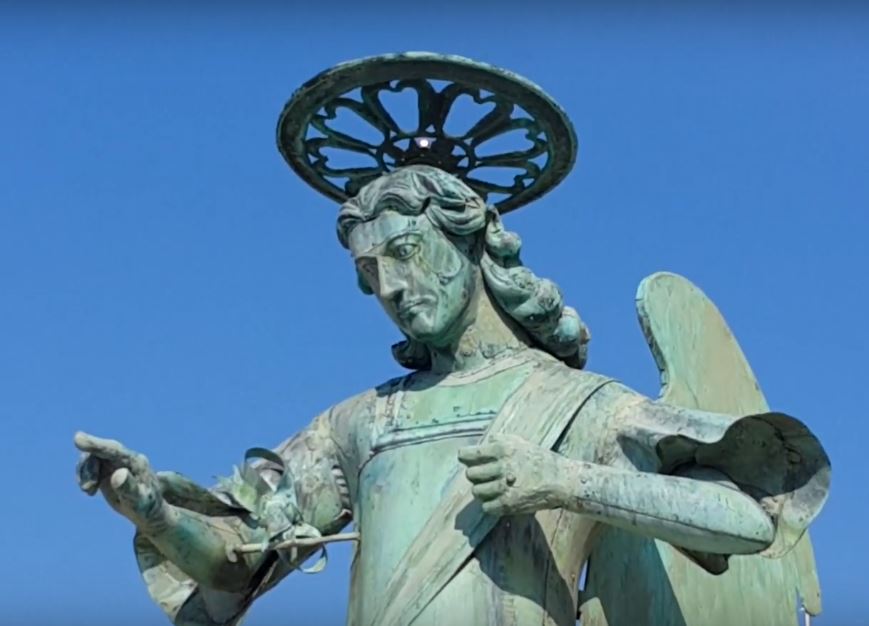Ljubljana related
We'll get to the video that the image at the top of this story comes out of the way first, as it shows both a car and a motorscooter underwater.
What follows are more traditional scenes of the undersea life you can find off the Slovenian coast, ending with a video of a conger eel attacking a shark
May 11, 2019
The City Council of Piran finally adopted a budget for the year 2019 this Friday, following a series of unsuccessful sessions that at certain point included the Mayor's making passing of the plan conditional on him staying in office.
Mayor Đenio Zadković had a difficult week after the commercial TV station POP TV found out about his website and some letters he had sent two years ago to various world leaders, including Pope Francis, former General Secretary of the United Nations Ban Ki-moon and then US presidential candidate Donald Trump. As Zadković, whose interests are philosophy and spirituality according to his autobiography, later explained, the letters were part of his art photography project.
In his 2016 letter to Donald Trump he proposes that his pictures be exhibited at Ground Zero in New York for the following reasons:
“When George W. Bush became president of the US I saw tragedy in his eyes. That was 9/11 and in that period the Idea of exposing my photopoems at GROUND ZERO started to rise. It may sound too ambitious, but that is the only place where I want to see them exposed. I'd like to find out if the initials of my name and surname have some kind of connection with those of the place where once the twins were; I want to know if Jung's synchronicity exists (now, not now or never?); and finally if the language of the unconscious still works in the name of love.”
To Ban Ki-moon, he proposed the solution for the “B zone”, the post WWII name for the coastal area that eventually became part of Slovenia and which during the related negotiations belonged to the so-called Territory of Trieste under direct responsibility of the UN Security Council:
“My plan is to establish a bank of United Nations in the Free Territory of Trieste/zone B in Koper and I would like you Mr. BAN KI-MOON after retiring from the presidency of the UN to undertake the presidency of the bank, the priority of which will be the introduction of a Universal Basic Income for everybody, starting with Africa and thus solving the problem of the current and likely future massive exodus. I trust you understand my plan and that there is no need to extrapolate into the future with further examples. Thank you for reading my letter and being sensitive to the problem of refugees (and I would like to add, the welfare of women).”
These letters, however, only came out after several of mayor’s unconventional Facebook posts that were directed at the more extreme of his GZOP party members caught the public’s attention. The Mayor laughed at the Pop TV report, thanking them for the free publicity and repeating his previous suggestion that Piran would make the best place for big international meetings. In translation:
“Ahahaha, POP TV, thank you for the advertisement. (…) Perhaps Putin and Trump will come to Piran after all. It is not too late yet.”
And
“Following this POP TV news I have a green light now to invite to the next philosophical duel our Slavoj Žižek, who is also from Portorož, and Jordan Peterson.”
And then several posts on the importance of understanding before criticizing, including:
“My world is pure, immaculate. My life is my pride. (…) I haven’t got a single enemy among those who know me. People who hate me are some of “my people” from the GZOP party because they didn’t get enough, hmmm. At the very beginning, when we started with the Portorož Movement forum, I wrote: "If we take our gold (victory) as our prey, then the collapse of the system will follow". And what you see is the collapse of the system, because of the hawks. What else should I tell you? The infamous letters you mentioned were written 3, 4, 5 years ago. I’ve been creating my photos for 10 years. Only a few can understand me through these photos, unfortunately. (…) I am here to make this municipality the most beautiful municipality in the world. How? Nicely, with your help, "the media", rather than with destroying of a mayor who you do not understand because you can’t, unfortunately.”
Although initially praised for its spontaneous democratic value, the Facebook group turned formal with the establishment of the Movement for the Municipality of Piran (GZOP) party, and has been struggling to remain united after gaining power. Five out of eight GZOP councillors voted against the budget proposed by Mayor this week, and when the proposal finally passed some of the members accused the mayor of “playing solo”.
The Mayor’s lack of political background, although considered a good thing by some as it appears to stand against corruption, seems to be causing serious operational problems due to lack of general political skills, including an understanding of administrative procedure and the use of proper channels and modes of communication.
The mayor concluded his string of Facebook posts with an explanation of the text accompanying a photo that POP TV used, in his view, inappropriately:
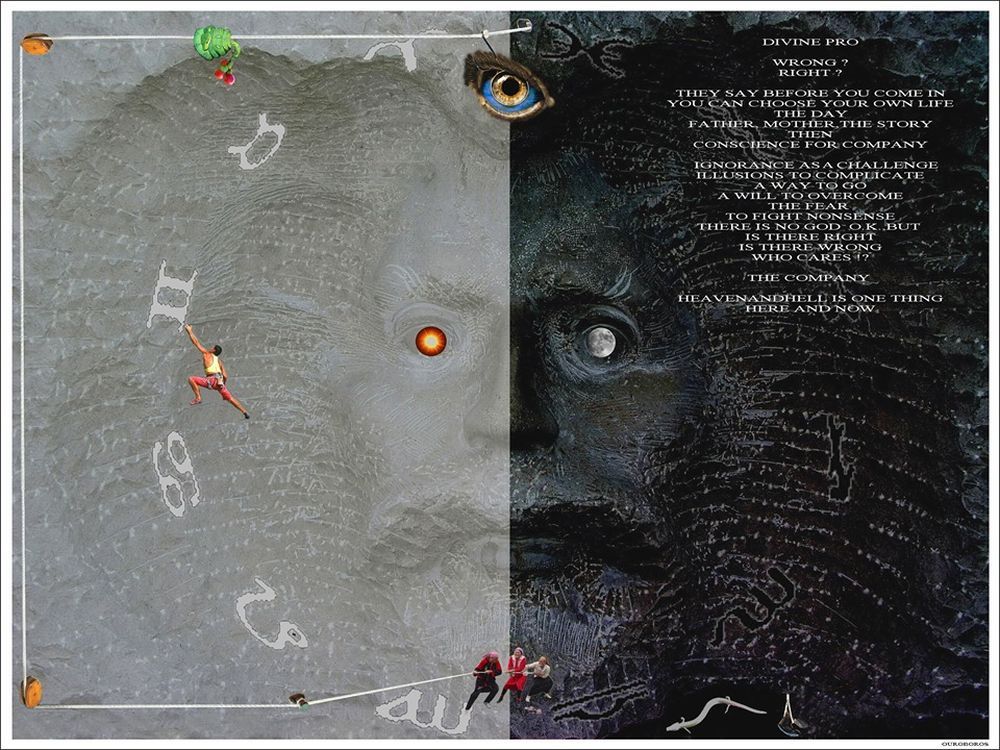
“Here I am delivering text, which will interpret my photograph named UP TO YOU, from which certain sentences that POP TV published were taken. The whole thing is written to improve understanding of the photo, which is full of symbolism, archetypes, archaic symbols and carries a strong message, which is so complex that without any explanation and knowing the symbols (the vocabulary of the unconscious) hardly anyone can understand it, while the photo I leave to your personal perception and, of course, imagination. I’ve always been saying, “If one person will understand what I think, I have won.” I am overjoyed that there are so many of you who understand. Thank you, dear Nejc [person who was commenting on Facebook], and thank you, who in these times and for many this unreasonable position, support me.”
Gibanje Portorož is a Facebook group that played a crucial role in last local elections in the Municipality of Piran. It has a little over 5,000 members, some of whom express quite extremist views on the political process, and the Mayor has struggled to distance himself from these since running the office. The group was closed several days ago.
For those who live and work in Piran, now that the budget has finally been passed perhaps the Mayor’s real work can begin.
This documentary, from 2011, tells the story of the first black African leader in (as the producers put it) “Eastern Europe” – the then recently elected Mayor of Piran, Peter Bossman. An inspirational story for anyone who’s moved to Slovenia, and especially for anyone struggling to learn the Language – in Slovene with English subtitles.
Yes, it’s a commerical for sports equipment, but it’s also a good presentation of the diversity that makes Slovenia such an attractive destination for short-term visitors and long-term residents who want some variety in the scenes and activities on offer, and all within a a couple of hours from each other.
Unless you choose to travel by bike, foot, kayak and foot, in which case it make take a little longer…
This week's photo comes from a recent search we did through Flickr for a story on spending from four to 48 hours in Piran. It was taken by Anna & Michal, but to really appreciate the view you'll need to click here to see the full 8MB image, which you can move around and explore. You can also download a copy of it here.
Part of the appeal of Slovenia as a destination is the remarkable variety of landscapes, climates, cuisines and cultural heritage packed into a relatively small area, due to the young nation’s position at the crossroads of north, south, east and west Europe. Piran, and the Slovenian coastal region of Istria in general, is a fine example of this, giving the country and access to the Adriatic as well as an area famed for its wines, olives, persimmons, seafood, architecture and – on occasion – wind (known as the burja or bora). For both short-term visitors and life-long residents of Slovenia it represents an escape from the inland and the chance to enter another, more Venetian world, an opportunity that should be seized whenever possible.
We thus present a short guide to spending from four to 48 hours in Piran, with a choice of sights and activities that isn’t meant to be exhaustive, or exhausting, but rather a simple presentation of things to see and do that’ll let you say: “Yes, I’ve been to Piran, and I loved it”.
Essential Sightseeing in Piran: The Old Town and the Sea
The town is an old Venetian settlement, ruled by the lagoon-based city state from 1283 to 1797, and this history can still be seen in many of the more notable buildings. The town’s proximity to Italy also means that Piran, or Pirano, is essentially bilingual, as seen in the two languages on the signs and often heard in the accented dialect of locals. The best place to see Venetian architecture is in the Old Town, basically the whole of touristic Piran, which can easily be explored on foot in a few of hours – it’s mostly pedestrianised – with breaks for cafés, light shopping and food.
Notable buildings include the Benecanka Casa Veneziana Pirano, aka the Venetian House, now a boutique hotel, but one that you can still enjoy from the outside. It’s long been a tourist attraction, as seen in the postcard below, and is said to have been built by a Venetian merchant for a local women he fell in love with.
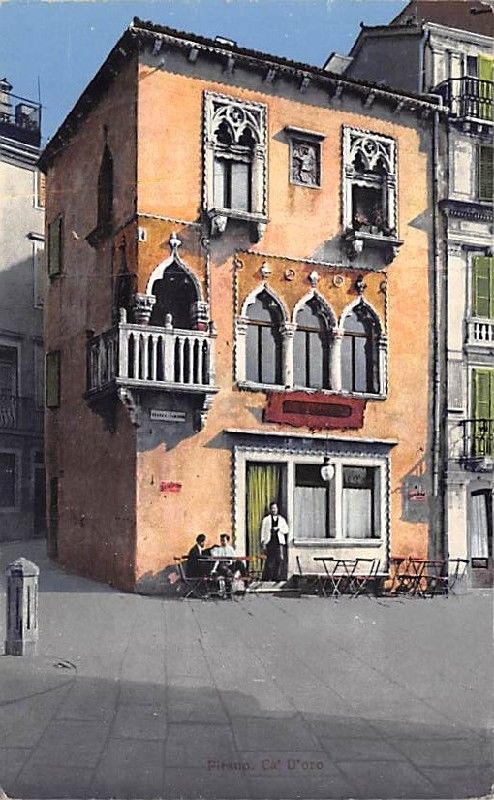
Postcard of the Venetian House, 1914. Source: Wikipedia
Venetian House can be found on the edge of Tartini Square, named after the composer Giuseppe Tartini (1692-1770), the first recorded owner of a Stradivarius. As old as it may look, this square is relatively recent. It was an open dock until 1894, when – the locals having grown sick of the smell of the sewage and waste that floated in the waters – it was filled in, with the statue of Tartini being placed there two years later.
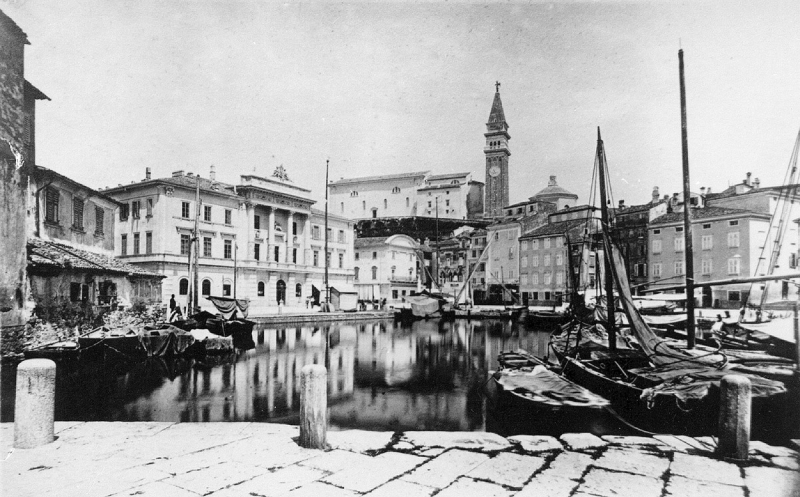
Photo of the dock that became Tartini Square, taken in the late 19th century, with Venetian House roughly in the middle. Source: Wikipedia
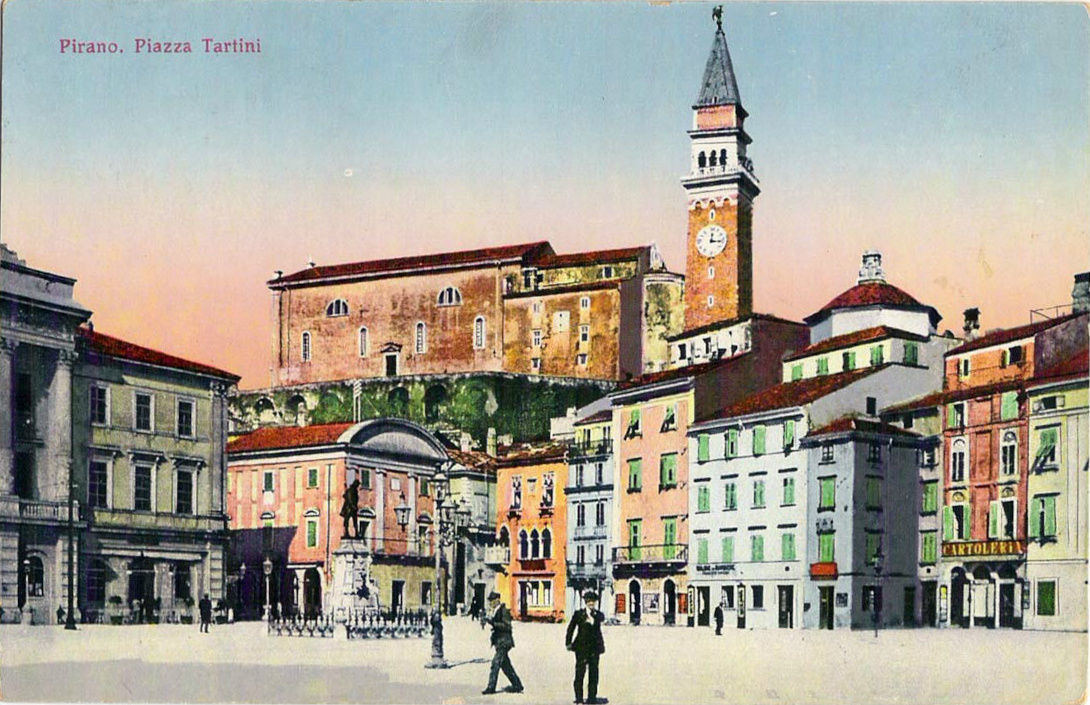
Postcard of Tartini Square in 1915. You can see the Venetian House behind the two men. Source: Wikipedia

Tartini Square in 200. Source: Wikimedia - © Plamen Agov • studiolemontree.com CC by 3.0. You can see more old photos of the square here.
It’s from this square that you can see another icon of Piran, the statue of the Archangel Michael, which for a little over 250 years has been sitting atop the church of St George, moving to show the direction of the wind to the town’s seafaring residents. (It was taken down for a short time 2018, for some much needed repairs)
St Michael. Screenshot from YouTube
Another structure to seek out are the Cloisters of Saint Francis Monastery, a place that still houses Franciscan monks and one that’s known for having great acoustics. For that reason it hosts the Piran Music Evenings and Tartini Festival, with the latter taking place late summer (this year, 2019, from August 22 to September 9), with the official website here.
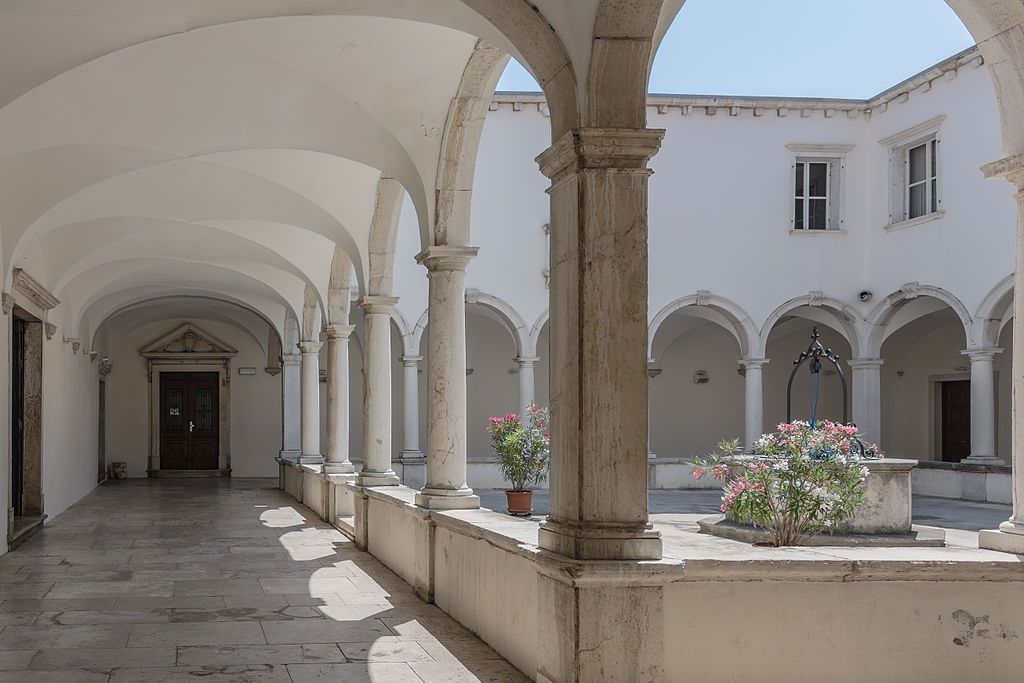
The Cloisters. Wikimedia - Isiwal CC-by-4.0
Before or after your walk around town you might want to sunbathe or swim, and you can do so at various spots, with some of what to expect (no sand) shown in the following video from Korea.
Things to do with 24 to 48 hours in Piran
Once you’ve seen the Old Town and bathed in the sun and/or the sea, you might want to take in some more of the related cultural and touristic offerings. These include the Sergej Mašera Maritime Museum, Piran Aquarium and the Museum of Underwater Activities(website down, at the time of writing), all of which offer what the names suggest. You can also find details of upcoming festivals, concerts and other events in Piran here.
If you’re spending longer in Piran then you might want to see a little more of the coast, that 47-km of Slovenia that separates Croatia from Italy. Within walking distance, or an easy cycle, drive, taxi or bus ride, is Portorož, a Riviera-style resort town with a very different feel to the Venetian peninsula. It’s here you’ll find casinos and beaches with recliners and umbrellas, with everything from top hotels and classy restaurants and a marina to pile ‘em high, sell ‘em cheap stores selling flip-flops, sunhats, sunglasses, inflatable items and so on. It’s not for everyone, but then neither is climbing Mount Triglav, so if it sounds interesting to you then take a look.
If you want to see more of the Venetian side of the coast then head on to Izola, although only if you haven’t been to Piran first. Meanwhile, the economic centre of the Slovenian Istria (aka Primorska) is the port town of Koper. While a little more developed than its neighbours, it still has another charming Venetian Old Town to explore.
Two areas that are more untouched, and where you’ll probably want to take your own food and drink, are Strunjan and Debeli rtič. Strunjan is a coastal nature reserve with many paths and trails for walking, hiking and biking, and the ideal place to get away from the crowds and ice sellers for a few hours. You can read our more detailed guide to this hidden treasure on coast here. A similar kind of experience can be had at Debeli rtič.
Tourist shopping in Piran
Piran is known for its salt pans, once the source of its wealth, and these are still in business, producing the famed local fleur de sel. Even if you don’t make the trip to see the seawater evaporating leaving these precious crystals, you’ll find stores all over town selling the stuff, both as a cooking ingredient and in various other preparation. Not made in Piran itself, but still in Slovenian Istria (aka Primorska or the Littoral), you might want to look out for local wines and produce. Wines offer include the red Refosco and white Malvazija, although there are also many other varieties and blends to enjoy, as outlined in this earlier article, while olives and PDO designated olive oil are produced nearby and are worth picking up or seeking out in restaurants.
Food and drink in Piran
As noted above, the region produces plenty of very drinkable wines, and often at prices lower than they’d command if they came with an Italian name, so do explore these if a fan of the grape. With regard to food, since you’re by the coast you should take the chance to check out the seafood restaurants. You’re also next to Italy, so don’t feel like you’re betraying Slovenia if you order some pasta and gelato.
If you’d like to learn more about Piran, including the stories that don’t make it into the tourist guides, then you can find all our articles on the town here
STA, 27 March 2019 - Foreign Minister Miro Cerar announced on Wednesday that Slovenia would issue a diplomatic note to Croatia over a grave border violation by a Croatian police boat in the Bay of Piran last Sunday.
Cerar said the boat crossing 2.5 km into Slovenian waters and even 1.3 km across the bay's midline was a special kind of provocation.
He spoke of an unnecessary escalation between the two countries, of a failure to honour international and EU law and of a violation of the Schengen border - by a country that would like to become a member of the Schengen area.
The newspaper Delo has reported that the Croatian police blamed their excursion on problems with navigation equipment.
"This is obviously just an excuse and as such completely unacceptable", Cerar commented, saying accepting this would be an "affront to the intelligence and abilities of the Croatian police authorities, which know exactly what they are doing".
The latest incident is part of a long history of run-ins in the bay featuring police and fishing boats on both sides of the border.
Since June 2017 the bay has also become the central theatre of the two sides' take on the international border arbitration decision, which Croatia is refusing to implement. The arbitration award gives 80% of the bay to Slovenia.
Cerar added today that Sunday's incident proved the implementation of the arbitration award was urgent, not only from the legal and political standpoints and bilateral relations but also because of "the entire European story".
"Such behaviour is not European and also serves as a poor example to the Western Balkans," Cerar said, adding the EU was constantly repeating that membership candidates needed to respect international law.
Captain and his Friday (Kapitan in njegov Petek) is an ethnographic documentary from 2014, presented here first in Slovene with English subtitles, and then in Slovene with Slovene subtitles. The Captain of the title is Mirko Bogić, while Friday is his companion, Savina Gorišek. At the time of filming Mirko was 97 and Savina 84, with both still sailing in Piran Bay, as they have done together for more than 40 years. The film takes the viewer through their daily routine, where they demonstrate that age is not an obstacle for an active life, full of love for each other and the sea.
A Slovenian team, working for the Piran-based organisation Morigenos, has discovered that the common bottlenose dolphins (Tursiops truncatus) living off the coast share the Bay of Trieste, dividing it based on time of day rather than territory, the first time such behaviour has been observed.
A paper published in the journal Marine Biology, “Behavioural and temporal partitioning of dolphin social groups in the northern Adriatic Sea”, and written by Tilen Genov, Tina Centrih, Polona Kotnjek, and Ana Hace, outlines how the researchers carried out their work, and what they learned. The team used the distinctive features on the dorsal fins of 38 dolphins to keep track of each individual, noting when and where the animals were sighted in the bay. An analysis of the data showed that the dolphins were divided into two groups of 19 and 13, with the remaining six making up a loose group of its own. The larger group of dolphins tended to following fishing trawlers between the hours of 07:00 and 3:00. In contrast, the smaller group of 13 were seen swimming with the trawlers, and hunted in the bay between 18:00 and 21:00. Dolphins from each group were rarely in the same area at the same time.

Source: Tilen Genov
In addition to revealing such temporal segregation for the first time in this species, the study is of interest because – as the paper concludes – “We demonstrate how different segments of the same population may behave very differently and have differing effects on human activities such as fishing (through potential depredation or gear damage). In turn, they may respond differently to anthropogenic pressures, as temporal partitioning may make animals either more or less vulnerable to disturbance from boat traffic.”
The full paper can be found here, while those interested in learning more about Morigenos can read an earlier story about the organisation here. The study reported in this story is also summarised in a short and relatively simple Slovene-English dual text here.
Get to Know the 17 Historical Towns of Slovenia
There are many ways to plan a trip around Slovenia and lenses through which to view it, and one way to explore the country is through its historic towns. But how to choose these in a land that’s got so many? One way is by turning to the work of the Association of Historical Towns (and Cities) of Slovenia (Združenje zgodovinskih mest Slovenije), a group that includes 17 mostly medieval towns sited around the country, each of which has its own story to tell, with the full list being Idrija, Jesenice, Kamnik, Koper, Kostanjevica na Krki, Kranj, Metlika, Novo mesto, Piran, Ptuj, Radovljica, Slovenske Konjice, Škofja Loka, Tržič, and Žužemberk.


